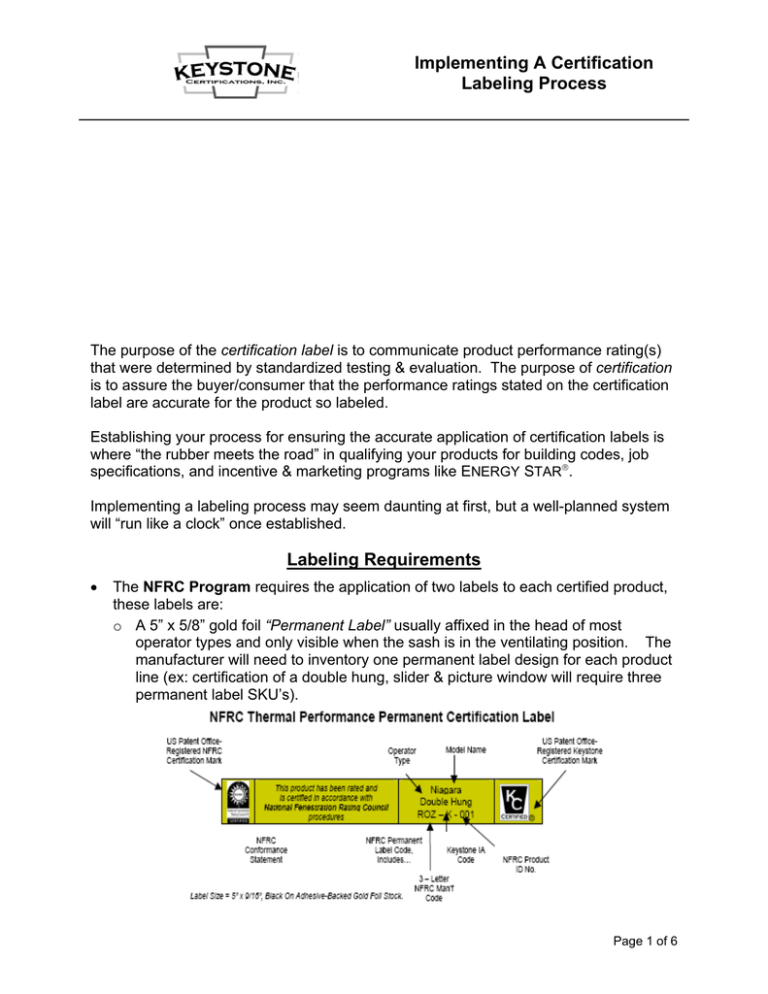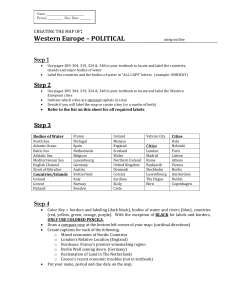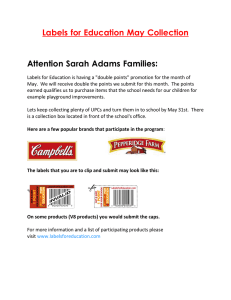Labeling Setup - Keystone Certifications, Inc.
advertisement

Implementing A Certification Labeling Process The purpose of the certification label is to communicate product performance rating(s) that were determined by standardized testing & evaluation. The purpose of certification is to assure the buyer/consumer that the performance ratings stated on the certification label are accurate for the product so labeled. Establishing your process for ensuring the accurate application of certification labels is where “the rubber meets the road” in qualifying your products for building codes, job specifications, and incentive & marketing programs like ENERGY STAR®. Implementing a labeling process may seem daunting at first, but a well-planned system will “run like a clock” once established. Labeling Requirements • The NFRC Program requires the application of two labels to each certified product, these labels are: o A 5” x 5/8” gold foil “Permanent Label” usually affixed in the head of most operator types and only visible when the sash is in the ventilating position. The manufacturer will need to inventory one permanent label design for each product line (ex: certification of a double hung, slider & picture window will require three permanent label SKU’s). Page 1 of 6 Implementing A Certification Labeling Process o A 4” square “Temporary Label” usually affixed to an interior glazing surface. The manufacturer will need to inventory one Temporary Label design for each different glazing option of each product line (ex: certification of clear IG with and without grids and low e / argon IG with and without grids requires FOUR temporary label SKU’s for EACH PRODUCT LINE). • The Keystone Structural Certification Program requires the application of a 5” x 5/8” gold foil Permanent Label, one SKU per configuration of product line (note: configuration variations like reinforced and un-reinforced versions of the same product must be differentiated by model name and require separate label SKU’s). Page 2 of 6 Implementing A Certification Labeling Process • If the manufacturer participates in both the NFRC and Keystone Programs, a “dual program” Permanent Label is available that meets the permanent labeling requirements for both programs. • If the NFRC Program manufacturer also participates in the ENERGY STAR® Program, an optional 4” x 6” NFRC Temporary Label with integral ENERGY STAR® compliance map is available for glazing configurations meeting Program requirements (typically requires at least the addition of low e). This reduces label SKU’s and complexity by eliminating the need for separate ENERGY STAR® Program labels. Page 3 of 6 Implementing A Certification Labeling Process Planning The Labeling Process The manufacturer should consider how to minimizing the number of label variations in order to reduce SKU’s and labeling complexity, for example: • If the motivation for labeling is to demonstrate compliance with the ENERGY STAR® program, consider only labeling products that meet the ENERGY STAR® requirements (typically low e / argon glazed units). Also consider offering a “high performance glass package” that always includes argon gas fill with low e (offering both low e with air AND low e with argon doubles the number of NFRC temporary label SKU’s). • If the motivation for labeling is to demonstrate product DESIGN PRESSURE (“AAMA Ratings”) to meet building code or job spec requirements, also consider reducing the number of label variations by selecting the rating that applies to your typical reinforcement configuration. (Multiple ratings are often determined for a product by testing various reinforcement configurations– each rating you wish to certify requires a different permanent label SKU.) Next consider WHO will be responsible for selecting the correct label for the products manufactured. Two individuals are typically considered: • Order Entry – the individual who inputs the window order is considering all the necessary details (model, size, glazing options, etc.) to select the correct labels for the “batch” of windows being ordered. This individual may select the correct number of labels for the job and place them in a “Job Packet” with the Work Order and Cut Sheet documents, for application at final assembly. • Final Assembly – the second most popular individual for selecting the correct labels is the final assembler, who may already be responsible for inspecting each product by comparing it to the Work Order, thereby considering all the necessary details (model, size, glazing options, etc.) to select the correct labels. This person may tear labels off rolls located at the workstation and apply them directly to certified products. Page 4 of 6 Implementing A Certification Labeling Process The manufacturer must also consider HOW the labels will be produced, stored and inventoried to assure constant availability. Two methods are typically considered: • Outsourced, Rack Mounted Labels – for small manufacturers, the most popular and efficient method of obtaining and organizing labels is to purchase pre-printed labels and mounting them in a rack system at the workstation where they are to be selected for application. A simple wooden rack can be created organizing the labels by product in rows, and NFRC temporary labels by glazing options in columns. This organization assists the individual to consistently select the correct label, and simplifies the process of inventorying the labels. Page 5 of 6 Implementing A Certification Labeling Process • In-House Label Printing – larger manufacturers will want to consider investing in the hardware and software capability for producing their own permanent and temporary labels on demand. This type system is typically linked to the order entry software and printed for application on the production floor at the workstation where the labels are to be applied via bar-code scanning and commercial label printing equipment. This system is very efficient, but unfortunately may also be very expensive! If you consider these options up front, and which options “fit” your organization and manufacturing environment, establishing your labeling process will be much less of a daunting task! Always consult Keystone BEFORE establishing a labeling process to ensure you meet certification program requirements. Page 6 of 6



